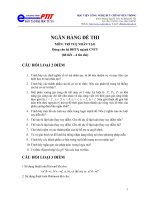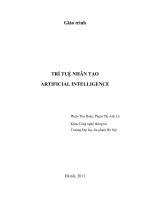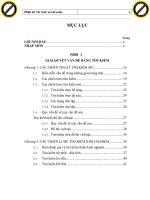Slide trí tuệ nhân tạo local search algorithms
Bạn đang xem bản rút gọn của tài liệu. Xem và tải ngay bản đầy đủ của tài liệu tại đây (1.38 MB, 40 trang )
Introduction to
Artificial Intelligence
Chapter 2: Solving Problems
by Searching (5)
Local Search Algorithms &
Optimization Problems
Nguyễn Hải Minh, Ph.D
CuuDuongThanCong.com
/>
Outline
1.
2.
3.
4.
5.
Optimization Problems
Hill-climbing search
Simulated Annealing search
Local beam search
Genetic algorithm
05/29/2018
Nguyễn Hải Minh @ FIT
CuuDuongThanCong.com
2
/>
Local Search Algorithms &
Optimization Problems
❑Previous lecture:
o Path to Goal is solution to problem
→systematic exploration of search
space: Global Search
❑This lecture:
o A State is solution to problem (path
is irrelevant)
o E.g., 8-queens
→ Different algorithms can be used:
Local Search
05/29/2018
Nguyễn Hải Minh @ FIT
CuuDuongThanCong.com
3
/>
Two types of Problems
Goal
Satisfaction
Optimization
reach the goal node
Constraint Satisfaction
Optimize objective f(n)
Constraint Optimization
Local Search Algorithms
Global Search Algorithms
05/29/2018
Nguyễn Hải Minh @ FIT
CuuDuongThanCong.com
4
/>
Local Search Algorithms &
Optimization Problems
❑Global search:
o Can solve n-queen for n = 200
o Algorithm: ?
❑Local search:
o Can solve n-queen for n = 1,000,000
o Algorithm:
• Hill-climbing
05/29/2018
Nguyễn Hải Minh @ FIT
CuuDuongThanCong.com
5
/>
Local Search Algorithms &
Optimization Problems
❑Local search
o Keep track of single current state
o Move only to neighboring states
o Ignore paths
❑Advantages:
1. Use very little memory
2. Can often find reasonable solutions in large or
infinite (continuous) state spaces.
05/29/2018
Nguyễn Hải Minh @ FIT
CuuDuongThanCong.com
6
/>
Local Search Algorithms &
Optimization Problems
❑“Pure optimization” problems
o All states have an objective function
o Goal is to find state with max (or min) objective value
o Does not quite fit into path-cost/goal-state
formulation
o Local search can do quite well on these problems.
❑Examples:
o
o
o
o
o
n-queens
Machine Allocation
Office Assignment
Travelling Sale-person Problem
Integrated-circuit design…
05/29/2018
Nguyễn Hải Minh @ FIT
CuuDuongThanCong.com
7
/>
State-space Landscape of Searching for Max
05/29/2018
Nguyễn Hải Minh @ FIT
CuuDuongThanCong.com
9
/>
Hill-climbing search
❑A loop that continuously moves in the direction of increasing
value → uphill
o terminates when a peak is reached
→ greedy local search
❑Value can be either:
o Objective function value (maximized)
o Heuristic function value (minimized)
❑Characteristics:
o Does not look ahead of the immediate neighbors of the current state.
o Can randomly choose among the set of best successors, if multiple
have the best value
→ trying to find the top of Mount Everest while in a thick fog
05/29/2018
Nguyễn Hải Minh @ FIT
CuuDuongThanCong.com
10
/>
Hill-climbing search
Locality: move to best node
that is next to current state
Termination: stop when local neighbors
are no better than current state
This version of HILL-CLIMBING found local maximum.
05/29/2018
Nguyễn Hải Minh @ FIT
CuuDuongThanCong.com
11
/>
Hill-climbing example: n-queens
❑n-queens problem:
o complete-state formulation:
• All n queens on the board, 1 per column
o Successor function:
• move a single queen to another square in the same column.
→Each state has ? sucessors
❑Example of a heuristic function h(n):
o the number of pairs of queens that are attacking each other
(directly or indirectly)
o We want to reach h = 0 (global minimum)
05/29/2018
Nguyễn Hải Minh @ FIT
CuuDuongThanCong.com
12
/>
Hill-climbing example: 8-queens
❑(c1 c2 c3 c4 c5 c6 c7 c8) = (5 6 7 4 5 6 7 6)
The best moves
❑An 8-queens state with heuristic cost estimate h=17, showing the
value of h for each possible successor obtained by moving a queen
within its column.
CuuDuongThanCong.com
/>
Hill-climbing example: 8-queens
❑(c1 c2 c3 c4 c5 c6 c7 c8) = (8 3 7 4 2 5 1 6)
❑A local minimum in the 8-queens state space; the state has h=1 but
every successor has a higher cost.
CuuDuongThanCong.com
/>
Performance of hill-climbing on 8-queens
❑Randomly generated 8-queens starting states
o 14% the time it solves the problem
o 86% of the time it get stuck at a local minimum
❑However…
o Takes only 4 steps on average when it succeeds
o And 3 on average when it gets stuck
(for a state space with ~17 million states)
05/29/2018
Nguyễn Hải Minh @ FIT
CuuDuongThanCong.com
15
/>
Hill-climbing drawbacks
❑Local Maxima: a peak higher than its
neighboring states but lower than the
global maximum
→ Hill-climbing is suboptimal
❑Ridge: sequence of local maxima
difficult for greedy algorithms to
navigate
❑Plateau: (Shoulders) an area of the
state space where the evaluation
function is flat.
CuuDuongThanCong.com
/>
Escaping Shoulders: Sideways Moves
❑If no downhill (uphill) moves, allow sideways
moves in hope that algorithm can escape
o Need to place a limit on the possible number of
sideways moves to avoid infinite loops
❑For 8-queens
o Now allow sideways moves with a limit of 100
o Raises percentage of problem instances solved
from 14 to 94%
o However….
• 21 steps for every successful solution
• 64 for each failure
05/29/2018
Nguyễn Hải Minh @ FIT
CuuDuongThanCong.com
17
/>
Hill-climbing variations
1. Stochastic hill-climbing
o Random selection among the uphill moves.
o The selection probability can vary with the steepness
of the uphill move.
→ converges more slowly than steepest ascent, but in
some state landscapes, it finds better solutions
2. First-choice hill-climbing
o Generating successors randomly until a better one is
found.
→ Useful when there are a very large number of
successors.
3. Random-restart hill-climbing
05/29/2018
Nguyễn Hải Minh @ FIT
CuuDuongThanCong.com
18
/>
Random Restarts Hill-climbing
❑Tries to avoid getting stuck in local maxima.
❑Different variations
o For each restart: run until termination vs run for a fixed
time
o Run a fixed number of restarts or run indefinitely
❑Analysis
o Say each search has probability p of success
• E.g., for 8-queens, p = 0.14 with no sideways moves
o Expected number of restarts?
o Expected number of steps taken?
CuuDuongThanCong.com
/>
Search using Simulated Annealing
❑Idea:
Escape local maxima by allowing some “bad” moves
(downhill) but gradually decrease their size and frequency
• Probability of taking downhill move decreases with
number of iterations, steepness of downhill move
• Controlled by annealing schedule
→ Inspired by tempering of glass, metal
05/29/2018
Nguyễn Hải Minh @ FIT
CuuDuongThanCong.com
20
/>
Physical Interpretation of Simulated Annealing
❑Annealing = physical process of cooling a liquid or metal
until particles achieve a certain frozen crystal state.
o Simulated Annealing:
• free variables are like particles
• seek “low energy” (high quality) configuration
• get this by slowly reducing temperature T, which particles move
around randomly
05/29/2018
Nguyễn Hải Minh @ FIT
CuuDuongThanCong.com
21
/>
Search using Simulated Annealing
Good neighbors:
always accept
better local moves
Bad neighbors: accept
in proportion to
“badness”
Temperature reduction:
slowly decrease T over time
05/29/2018
Nguyễn Hải Minh @ FIT
CuuDuongThanCong.com
22
/>
Effect of Temperature
∆𝐸ൗ
𝑒 𝑇
∆𝐸
If temperature decreases slowly enough, the algorithm will find
a global optimum with probability approaching 1.
05/29/2018
Nguyễn Hải Minh @ FIT
CuuDuongThanCong.com
23
/>
Search using Simulated Annealing
❑Despite the many local maxima in this graph, the global
maximum can still be found using simulated annealing
05/29/2018
Nguyễn Hải Minh @ FIT
CuuDuongThanCong.com
24
/>
Example on Simulated Annealing
❑Lets say there are 3 moves available, with changes in the objective
function of
o ∆𝐸1 = −0.1
o ∆𝐸2 = 0.5 (good move)
o ∆𝐸3 = −5
❑Let T=1, pick a move randomly:
o if ∆𝐸2 is picked, move there.
o if ∆𝐸1 ∆𝐸3 are picked:
∆𝐸
• move 1: prob1 = 𝑒 ൗ𝑇 = 𝑒 −0.1 = 0.9,
∆𝐸
• move 3: prob3 = 𝑒 ൗ𝑇 = 𝑒 −5 = 0.05
❑T = “temperature” parameter
90% of the time we will
accept this move
5% of the time we will
accept this move
o high T => probability of “locally bad” move is higher
o low T => probability of “locally bad” move is lower
o Typically, T is decreased as the algorithm runs longer
• i.e., there is a “temperature schedule”
05/29/2018
Nguyễn Hải Minh @ FIT
CuuDuongThanCong.com
25
/>
Simulated Annealing in Practice
❑Simulated annealing was first used extensively to solve VLSI
layout problems in the early 1980s.
❑Other applications:
o Traveling Salesman Problem
o Factory Scheduling
o Timetable Problem
o Image Processing
o …
❑Useful for some problems, but can be very slow
→Because T must be decreased very gradually to retain optimality
❑How do we decide the rate at which to decrease T?
→This is a practical problem with this method
05/29/2018
Nguyễn Hải Minh @ FIT
CuuDuongThanCong.com
26
/>









